Xanthophysa is a monotypic moth genus of the family Crambidae described by Eugene G. Munroe in 1964. It contains only one species, Xanthophysa psychialis, the xanthophysa moth, described by George Duryea Hulst in 1886. It is found in North America, where it has been recorded from Alabama, Florida, Illinois, Indiana, Kentucky, Maine, Mississippi, New Hampshire, New Jersey, North Carolina, Ohio, Ontario, Quebec, South Carolina and Tennessee.

Globia oblonga, the oblong sedge borer, is a moth of the family Noctuidae. The species was first described by Augustus Radcliffe Grote in 1882. It is found in parts of Canada and the United States

Globia subflava, the subflava sedge borer or yellow sedge borer, is a moth of the family Noctuidae. The species was first described by Augustus Radcliffe Grote in 1882. It is found in North America from Nova Scotia west to British Columbia, south to New Jersey in the east and Utah and California in the west.
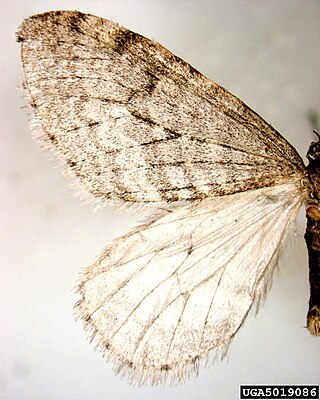
Operophtera bruceata, the Bruce spanworm, hunter's moth, or native winter moth is a moth of the family Geometridae. The species was first described by George Duryea Hulst in 1886. It is found from coast to coast in southern Canada and the northern parts of the United States.
Idia immaculalis, the immaculate idia, is a litter moth of the family Erebidae. The species was first described by George Duryea Hulst in 1886. It is found in North America from at least California, north and east across Montana to southern Alberta and Saskatchewan.
Catastia actualis is a species of snout moth in the genus Catastia. It was described by George Duryea Hulst in 1886. It is found from Saskatchewan and Alberta to Colorado and north-eastern California to Lake Tahoe.

Gesneria centuriella is a species of moth in the family Crambidae described by Michael Denis and Ignaz Schiffermüller in 1775. It is found from Europe, east to Japan. It is also present in Greenland and northern North America.
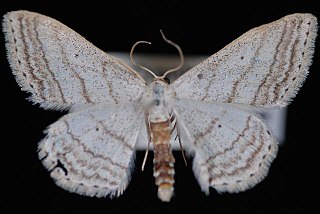
Scopula ancellata, the angled wave moth or pointed-winged wave, is a moth of the family Geometridae. It was described by George Duryea Hulst in 1887. It is found in North America from Quebec west to the Northwest Territories and British Columbia and south to Michigan, Indiana and Arizona. The habitat consists of mixed wood and coniferous forests.

Eupithecia nimbicolor is a moth in the family Geometridae first described by George Duryea Hulst in 1896. It is found in North America from eastern Newfoundland and Labrador to western British Columbia and from Alaska to Arizona.
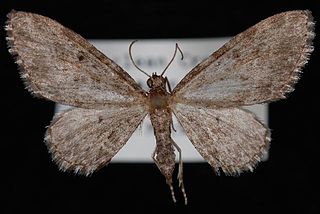
Eupithecia lachrymosa is a moth in the family Geometridae first described by George Duryea Hulst in 1900. It is found in North America from central Saskatchewan west to southern Vancouver Island, north to British Columbia and Alberta and south to California.

Eupithecia stellata is a moth in the family Geometridae first described by George Duryea Hulst in 1896. It is found in North America from central Manitoba to northern Alberta and south to California and Mexico.

Eupithecia niveifascia is a moth in the family Geometridae first described by George Duryea Hulst in 1898. It is found in North America from south-western Alberta west to Vancouver Island, north to northern coastal British Columbia and south to New Mexico.

Eupithecia coloradensis is a moth in the family Geometridae first described by George Duryea Hulst in 1896. It is found in North America from western Quebec and western Ontario south to North Carolina, west to New Mexico, Arizona, Colorado and south-eastern Alberta.
Crambus trichusalis is a moth in the family Crambidae. It was described by George Duryea Hulst in 1886. It is found in North America, where it has been recorded from Alberta, Saskatchewan, Montana, North Dakota and South Dakota. The habitat consists of grasslands.
Loxostege anartalis is a moth in the family Crambidae. It was described by Augustus Radcliffe Grote in 1878. It is found in North America, where it has been recorded from coast to coast in Canada. In the west, the range extends south to California.

Loxostege lepidalis is a moth in the family Crambidae. It was described by George Duryea Hulst in 1886. It is found in North America, where it has been recorded from Alberta and eastern Washington to California and New Mexico.
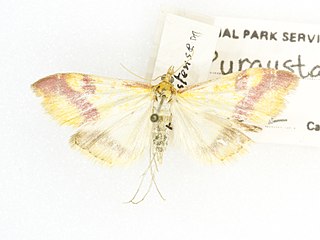
Pyrausta scurralis is a moth in the family Crambidae. It was first observed and described by George Duryea Hulst in 1886. It is found in North America, where it has been recorded/reported in the Canadian provinces of Ontario, Manitoba and Saskatchewan to the US states, California, Arizona, and New Mexico and in Mexico.
Saucrobotys fumoferalis, the dusky saucrobotys moth, is a moth in the family Crambidae. It was described by George Duryea Hulst in 1886. It is found in North America, where it has been recorded from Nova Scotia west to British Columbia, north to Yukon, and south to Pennsylvania, Illinois and California. The habitat consists of boreal forests, mixed forests and woodlots.
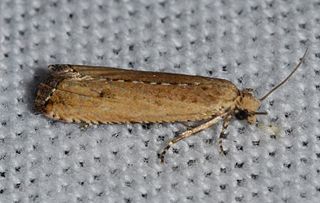
Bactra verutana, the javelin moth, is a species of moth of the family Tortricidae. It is found in North America, where it has been recorded from Florida, Texas, Mississippi, North Carolina, Indiana, Missouri, Ontario, Alberta, Quebec and Labrador. It is also found in Cuba, Mexico, Panama, Paraguay, Puerto Rico, Mozambique and South Africa. The habitat consists of prairies, aspen parkland, foothills and mixed wood areas.
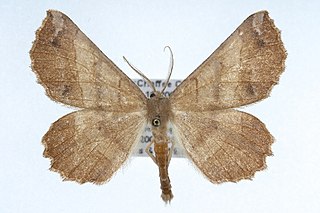
Euchlaena johnsonaria, or Johnson's euchlaena moth, is a moth of the family Geometridae. The species was first described by Asa Fitch in 1870. It is found in North America, where it has been recorded from southern coastal British Columbia east to Nova Scotia, south to New Jersey, Missouri and Oregon. The habitat consists of deciduous wooded areas.













